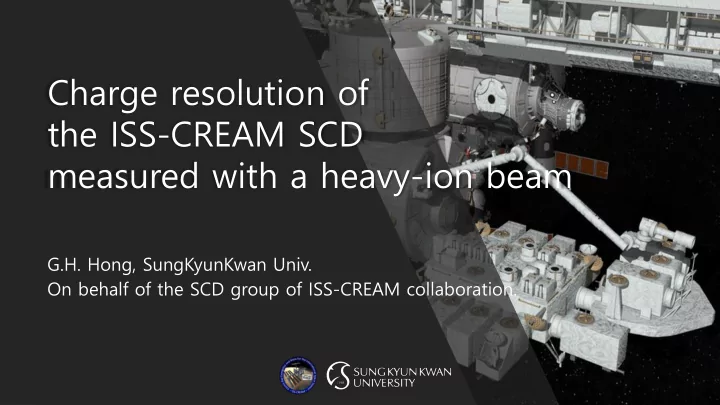

Charge resolution of the ISS-CREAM SCD measured with a heavy-ion beam G.H. Hong, SungKyunKwan Univ. On behalf of the SCD group of ISS-CREAM collaboration.
Contents • Introduction • Instrument for the heavy-ion beam test • Trigger detector • SCD prototype electronics • Data analysis • Result • Summary
Introduction The C osmic R ay E nergetics A nd M ass experiment at the I nternational S pace S tation The Cosmic Ray Energetics and Mass experiment • at the International Space Station (ISS-CREAM) is designed to measure the energy and composition of energetic cosmic rays at the International Space Station. ISS-CREAM payload will be launched and installed • at the ISS in August 2017. 2017-07-25 ICRC2017, Busan 3
Introduction Silicon charge detector (SCD) In ISS-CREAM Payload SCD Balloon-borne CREAM (2004~2016): Double -layer SCD Targets TCD Instrument Calorimeter BSD BCD Not Shown (Located behind Power Dist Instrument Instrument ribution Boxes - Housekeeping Box ISS-CREAM: - Science Flight Computers Quadruple -layer SCD 2017-07-25 ICRC2017, Busan 4
People who contributed to this work SCD group: I.H. Park, J. Lee, Crew for heavy-ion Beam test at CERN: H.Y. Lee, J.A. Jeon, S. Jeong, S. Jeong, S. Nutter, G.H. Hong, G.H. Choi, G.H. Choi, G.H. Hong. G. Gaikove, M.B. Kim, H.M. Jeong.
Instrument ▪ Beam line : North area H4 and H8 at CERN ▪ Beam status: Primary lead ion, fragmented down. - Momentum of heavy-ion : 60.2 GeV/c per nucleon. - A/Z = 2.0 ▪ Beam size RMS ~ 1cm Trigger detector SCD prototype 4 layer Beam 2017-07-25 ICRC2017, Busan 6
Instrument SCD prototype 4-layer configuration of silicon sensor with 128 pixels and readout electronics which were of the same types as the ones installed in the ISS-CREAM SCD. (A) (C) (B) (D) 2017-07-25 ICRC2017, Busan 7
Data analysis Data selection and analysis Convert the energy loss measurement(dE/dx) to the charge(Z). • The double-layer charge distribution was obtained by selecting the central band • of the 2- dimensional plot and taking the average of Z1 and Z2. The triple-layer and quadruple-layer charge measurements were obtained by • selecting such central bands in correlation. 1st layer and another layer Charge distribution of the ions 2017-07-25 ICRC2017, Busan 8
Result (Preliminary) Charge resolution Charge resolution (in charge unit) The charge resolution improves as the number of 1 layer 2 layer 4 layer • layers increases. C 0.213 0.177 0.117 The charge resolution measured with four layers Fe 0.222 0.160 0.118 • shows twice batter then single layer result. average 0.270 0.178 0.137 He 0.45 0.40 1 layer 2 layers 4 layers 0.35 Li B C 0.30 Fe O N Be Si F Ne Na Ma Al S 0.25 P 0.20 0.15 0.10 0.05 0 5 10 15 20 25 30 Charge distribution of the ions Charge resolution of the ions from He to Zn 2017-07-25 ICRC2017, Busan 9
Result Linearity in response Charge Peaks We have been trying to figure out where this • 30 non-linearity comes from. 25 No non-linearity was found in a stand-alone • 20 test of ADC on the digital board. Mean_Z 15 We suspect that this non-linearity originates • from the preamplifier on the analog 10 electronics board. Slightly non-linear 5 Once the origin of the non-linearity is found, • 0 we can correct it. 0 5 10 15 20 25 30 Z 2017-07-25 ICRC2017, Busan 10
Summary ▪ ISS-CREAM SCD can measure cosmic rays up to z = 30. ▪ The instrument requirement of the SCD on charge resolution is met (𝜀𝑎 = 0.137 e < 0.2 e) ▪ Non-linearity : the stand-alone test of preamplifier will follow to find its origin. 2017-07-25 ICRC2017, Busan 11
Recommend
More recommend